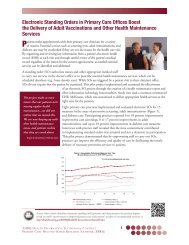Sustainability, Partnership, and Teamwork in Health IT Implementation
Sustainability, Partnership, and Teamwork in Health IT Implementation
Sustainability, Partnership, and Teamwork in Health IT Implementation
You also want an ePaper? Increase the reach of your titles
YUMPU automatically turns print PDFs into web optimized ePapers that Google loves.
elationships <strong>in</strong>volved a large patient care delivery organization with negotiat<strong>in</strong>g clout <strong>and</strong>/or <strong>in</strong>ternal<br />
health <strong>IT</strong> experience act<strong>in</strong>g as the l<strong>in</strong>k to the vendor.<br />
Other Cross-Organization <strong>Partnership</strong>s<br />
Of the partnerships that were built or enhanced as a result of the plann<strong>in</strong>g <strong>and</strong> implementation grant<br />
opportunities (65 of them), nearly all cont<strong>in</strong>ued to work together <strong>in</strong> part or <strong>in</strong> whole after the end<br />
of the grant period on health improvement projects (with two exceptions). <strong>Partnership</strong>s ranged <strong>in</strong><br />
size <strong>and</strong> composition, but more than half the grant projects <strong>in</strong>cluded one or more private physician<br />
practices (a majority of which had fewer than five physicians), hospitals (a majority were Critical<br />
Access Hospitals or small rural hospitals), a university, <strong>and</strong> a health <strong>IT</strong> vendor. Grantees with more<br />
complex <strong>and</strong> larger projects—those with more than one type of patient care delivery organization<br />
<strong>and</strong>/or <strong>in</strong>volv<strong>in</strong>g more than 10 organizations of any type—were as likely to cont<strong>in</strong>ue their<br />
partnerships with full versus partial participation as their smaller or counterparts or those <strong>in</strong>clud<strong>in</strong>g<br />
only one type of patient care delivery organization.<br />
Includ<strong>in</strong>g an organization whose primary mission is not care delivery appears advisable: partnerships<br />
<strong>in</strong>volv<strong>in</strong>g organizations such as professional associations, health <strong>IT</strong> vendors, <strong>and</strong>/or a consultant<br />
were significantly more likely to cont<strong>in</strong>ue with full participation than partnerships without these<br />
organizations <strong>in</strong>volved. <strong>Implementation</strong> projects with a “major rural” focus were also more likely to<br />
report all partners cont<strong>in</strong>u<strong>in</strong>g to work together after the grant, compared with other grantees.<br />
Grantee <strong>in</strong>terviews suggested several features of successful health <strong>IT</strong> partnerships: a shared view<br />
among partners that health <strong>IT</strong> is an enabler to a common goal, trust among partners, <strong>and</strong>, when<br />
relatively small organizations with constra<strong>in</strong>ed resources are <strong>in</strong>cluded, also <strong>in</strong>clud<strong>in</strong>g a larger, wellresourced<br />
partner (see box).<br />
5<br />
Executive Summary

















